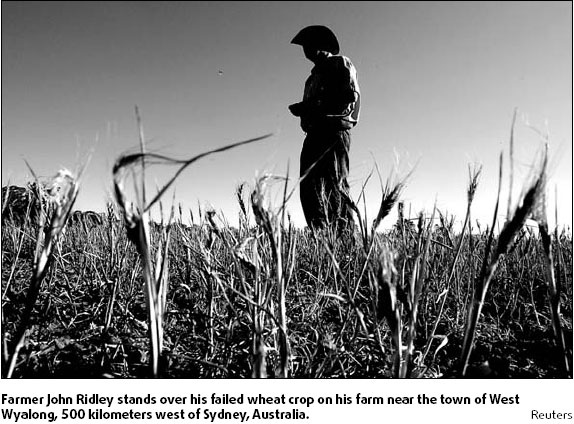Drought drives Australian wheat farmers to brink

Farmer John Ridley won't be harvesting so much as a bag of wheat this season from fields that stretch to the horizon as Australia's worst drought in 100 years takes its toll on the country's grain belt.
Beneath a cloudless sky, Ridley, a descendant of one of Australia's pioneering farming families, pulls a clump of brittle stubble from the dusty earth.
"It should be this high, waving green in the breeze," he says. "Farmers are in a stunned state at the moment. In a state of disbelief, shock, helplessness."
His farm is in the epicenter of devastation from the drought, about 500 kilometers west of Sydney. Prime wheat growing territory, the district normally grows much of the wheat that makes Australia the world's second-biggest exporter.
Yet this year the district will produce almost nothing.
Drought which has struck intermittently since 2002, and which farmers hoped had ended in April with rains that prompted them to sow their fields, returned three months ago and devastated the crops of entire farming communities.
This is the first time in over 40 years of farming that Ridley will not harvest any wheat from the 2,500 hectares he planted at a cost of around A$500,000 ($445,000). It is a total loss, and it follows drought which fried last year's crop too.
Farmers say that even after the massive financial loss of crop failure and the hollowing out of social structure in the countryside, it is the swirling clouds of dust from the parched earth that finally cracks nerves.
"I've never experienced so much wind in my life," Ridley says, batting at a swarm of flies buzzing around his face.
It is like a cruel trick of nature, Ridley says. Good early rain in the planting season encouraged farmers to plant big crops to attempt to make up for losses inflicted by last year's drought.
Then drought struck to kill the crop, pushing already-indebted farmers to the brink of financial collapse. It costs around A$250 a hectare for fertilizer and seed to plant wheat and Ridley's plant of 2,500 hectares is typical of medium-sized farms.
National Australia Bank recently said that average Australian farm debt was A$412,000, up from A$150,000 in 1990. Many farms now owe much more than this, often millions, farmers say.
"No crops. No pasture. Fodder all gone. And no money," Ridley said. "Those of us who can, will face up to one more year and I reckon that will be it," he said.
Others have lost much more than Ridley.
Around 50 kilometers away near the dying town of Barmedman, population around 200 and falling, Angus McLaren planted 5,000 hectares at a cost of over A$1 million.
"It's pretty much all lost," he said, batting at flies on a dirt road next to his failed crop.
"It's unprecedented. We need a good year next year. We're just sliding into debt. At some stage you have to say 'enough is enough'," he said.
Agencies
(China Daily 10/25/2007 page16)














